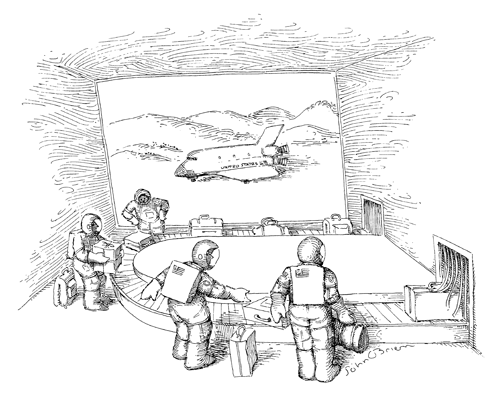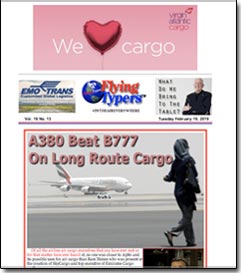| |
 |
 #INTHEAIREVERYWHERE |
| Vol. 18 No. 16 | Monday
March 4, 2019 |
 |
|
 |
The idea for these stories was not planned. They happened in the course of gathering editorial. Recently we had the good fortune to speak to Thomas Uschtrin of United Cargo in Moerfelden, Germany. Thomas stands at six foot seven. Beyond the obvious, he stands tall in performance and thought as well. Tall Thomas Thomas Uschtrin, United Cargo Sales Manager Germany, heads up a team of fourteen and has some big ideas for team and business development. But it’s all about building a strong, fluid cargo product for United Airlines from the ground up. Thomas puts it this way: “I love working together with our forwarder partners to create shipping solutions that are win-win. “We work at every aspect of our approach so that our customers can see by our actions in real time that we never forget how important they are. “The cargo business is a long-term relationship, not a hit-and-run affair. “Our 15 flights a day out of Germany, the economic engine of Europe, are a great foundation to build on. Then we go the extra mile and keep our customers close so that everyone knows what to expect,” Thomas said. “I am especially proud of the team that we have put together here. “Recently we gathered for a meeting in Barcelona, where I was especially impressed with how our people shared the strategies and tactics they have learned from experience to lift our collective effort. “United Cargo people care about each other and it shows in our daily work performance and how everyone pitches in, no matter the situation, to keep the commerce moving.” From Passenger To Cargo Thomas began his career at American Airlines as an intern in the passenger business, moving over to cargo with Continental in 1997. “Every aspect of my airline career has helped me better understand the importance of always working to grow friendships and understanding with colleagues and customers. “I experienced firsthand the merger of Continental and United into one airline and all that entailed. “Now that United and Lufthansa Cargo are involved in our exciting new joint venture, I can tell you that just as Rome was not built in a day, people at both carriers worked countless hours on the details of our cargo joint venture. “We took a gradual, thorough approach with our different synergies, and we have created a supreme logistics offering we’re all proud of. “For example, where we are conducting joint sales calls there is no hierarchy involved. Rather, both airlines’ offer an unbeatable combined strength. “I might add that the United-Lufthansa Cargo JV works, in very large part, because both airlines have top cargo management that is always approachable.” About Tall Thomas Thomas considers himself a life-long student of many things, but especially of music. “I have recently picked up my piano playing again, and I realize how much fun making music provides. “I live here in Germany, not far from FRA airport and yet very close to a natural forest, which is a great location for a nature-lover like me. “I often take the opportunity to run and hike a few miles, and favor Mediterranean cuisine. “I also love to travel to many places.” 2018 A Very Good Year “I saw the best results of my career in 2017 and 2018, and I’m confident that this year will also be solid. “For me, the most important contributor to a good life is having long-term relationships that are open, honest, and trusting. “It’s OK to make mistakes; that just means you’re human. Learning from mistakes is an excellent way to become a better person and better at whatever you do. “An open and honest contributor to others’ success: that is what I strive to be as a leader and partner,” Tall Thomas said. |
|
“Continuing a partnership marketing
cargo for Edelweiss that began in 2009 offers great opportunities for
both us and our customers, as we are able to complement our already strong
international network with additional routes in diverse markets,”
said Ashwin Bhat, (above) Head of Cargo, Swiss WorldCargo confirming the
agreement with Bernd Bauer CEO, Edelweiss. |
Karneval In Rhineland
|
Now for
everybody who loves aviation, and especially folks that today live and
work in air cargo, comes a unique opportunity. Right on
the heels of a major world gathering—Air Cargo Europe in Munich,
Germany at Transport Logistik June 4-7, the 70th anniversary of the Berlin
Airlift is being celebrated in grand style from June 10 until June 18.
Eight days full of events featuring the people and more than 40 aircraft
gathered from all over the world, returning to Germany, where modern air
cargo made history saving the city of Berlin in 1948-49.
|
|
If
You Missed Any Of The Previous 3 Issues Of FlyingTypers Access complete issue by clicking on issue icon or Access specific articles by clicking on article title |
||
 Vol. 18 No. 13
Vol. 18 No. 13 A380 Beat 777 On Long Route Cargo Chuckles for February 19, 2019 Ode To A380 Who Has The Next Big Idea? Cabin In The Sky Flossie's Moon |
 Vol. 18 No. 14 Turkish Opticool Moment Chuckles for February 22, 2019 Past Numbers & A Look Ahead A380 In A Field Of Flowers |
|
Publisher-Geoffrey Arend
• Managing Editor-Flossie Arend • Editor Emeritus-Richard
Malkin Film Editor-Ralph Arend • Special Assignments-Sabiha Arend, Emily Arend |
|